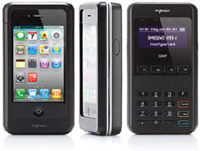Make Mobile POS Your Next Revenue Generator
By Mike Monocello, Business Solutions magazine
This ISV landed a mobile POS and payment solution for a national chain.
When brought up in conversation among VARs, the topic of mobile POS can yield any number of responses. Some are fearful the technology will displace traditional POS hardware sales. Others are fearful because they lack the knowledge to fully understand what mobile really entails. Some are being cautious, waiting to see if mobile POS is just a fad or a long-term shift. And, of course, some are merrily embracing mobility. Bob Leonard, managing partner of iMobile3, LLC, is one solutions provider who’s fully embraced the mobile shift. Indeed, if you didn’t notice the company name, the software vendor specializes in mobile solutions.
 According to Leonard, mobile POS is here, it’s now, and the rate of adoption is increasing rapidly. A great example of the why’s and how’s of mobile POS can be seen in a recent installation iMobile3 performed for a national chain. Leonard says that the chain wasn’t experiencing any problems which led management to reach out for a mobile solution. Rather, as is the case he’s seeing with most customers, the chain was interested in extending its POS to areas beyond traditional checkout lanes.
According to Leonard, mobile POS is here, it’s now, and the rate of adoption is increasing rapidly. A great example of the why’s and how’s of mobile POS can be seen in a recent installation iMobile3 performed for a national chain. Leonard says that the chain wasn’t experiencing any problems which led management to reach out for a mobile solution. Rather, as is the case he’s seeing with most customers, the chain was interested in extending its POS to areas beyond traditional checkout lanes.
For example, one use was taking the POS outside the store walls into the parking lot where seasonal items (e.g. flowers and mulch in the spring, Christmas trees during winter) are typically sold. As you might know, many stores look to drive revenue by increasing square footage of the store via a parking lot or porch shopping area. Additionally, there are just some items that can’t be sold inside the store. With these challenges in mind, the chain began looking for a mobile POS solution.
Leonard says that his company was given an opportunity to work on the project, first rolling out a pilot that involved a few stores within close proximity to the chain’s headquarters. The ISV goes on to explain that mobile POS solutions involve four key components: the hardware terminal (in this case, five iOS devices per store), software (iMobile3’s own software), the payment terminal (Ingenico iSMP mobile payment terminal), and the security features around the transaction (point-to-point encryption that secures card swipes).
Depending on its customer’s needs, iMobile3 can deliver its software as an out-of-the-box solution or perform custom work and sell the customer the code. In this case, Leonard says the client was using its own proprietary POS software in-lane and wanted iMobile3 integrated. The ISV customized its software to hook into the in-store system and tweaked the on screen layout of the mobile solution to closely mimic the screens and workflow of the in-store system. This allowed store associates to become quickly familiar with the new mobile solution.
Because the mobile solution integrates directly with the in-store system, transactions are processed in real time. This is opposed to some “mobile” solutions where a traditional POS terminal is wheeled outside and there’s no live connection with the in-store system. Many times, in such cases, transactions need to be batched and downloaded at the end of the day.
The ISV also added functionality to its mobile software to give store associates additional productivity tools. For instance, the mobile device could also be used to perform price checks or do inventory.
After the 60-day pilots were completed, a full-scale rollout was initiated. Leonard says each store asked for about 20 devices, varying in both form factor (iPad vs. iPod) and connectivity (Wi-Fi vs. cellular). The use case dictated which devices were rolled out.
When it comes to challenges and obstacles, Leonard says there were many, but none necessarily related to technology. “Mobile is so disruptive to internal store operations,” he explains. “These mobile payment devices are being used outside the typically locked down areas. As soon as you unbolt the POS from a countertop, stores immediately have new security risks, are required to manage devices, perform new training, and so on.”
One way the ISV helps with security is AirWatch, which provides mobile device management capabilities to the chain’s IT department. Additionally, Ingenico has its Terminal Manager Services, which helps secure the payment terminals. Combined, these two can help keep device data secure. Beyond technological security, there must be education of the store’s employees about the proper use and security of mobile POS devices.
Leonard says he expects the chain (which includes hundreds of stores) to roll out more mobile solutions in the future. Even more exciting, he says that all indicators point to 2013 being a year of mobile POS pilots turning into real installs. He says that many customers who used to say mobile was just an unnecessary expense are now returning to him with a new outlook on the technology.
